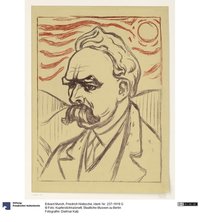
"Nietzsche´s body of work touched a wide range of topics, including art, philology, history, religion, tragedy, culture, and science. His writing spans philosophical polemics, poetry, cultural criticism, and fiction while displaying a fondness for aphorism and irony.[25] His early inspiration was drawn from figures such as Arthur Schopenhauer, Richard Wagner, and Johann Wolfgang von Goethe. Prominent elements of his philosophy include his radical critique of truth in favor of perspectivism; his genealogical critique of religion and Christian morality and his related theory of master–slave morality;[17][26] his aesthetic affirmation of existence in response to the "death of God" and the profound crisis of nihilism;[17] his notion of the Apollonian and Dionysian; and his characterization of the human subject as the expression of competing wills, collectively understood as the will to power.[27] He also developed influential concepts such as the Übermensch and the doctrine of eternal return.[28][29] In his later work, he became increasingly preoccupied with the creative powers of the individual to overcome social, cultural and moral contexts in pursuit of new values and aesthetic health.[20]" - (en.wikipedia.org 30.10.2019)




